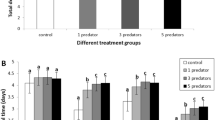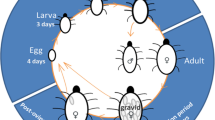Abstract
Predator-induced stress shows pronounced effects on prey by inducing behavioural, morphological, and physiological responses. Increasing evidence shows that these antipredator responses may also lead to changes in life-history traits such as aging and lifespan. However, little is known about how predator cues influence the fitness of preys and their transgenerational effects. Parental spider mites (Tetranychus urticae) were either raised on a leaf disc with or without cues from a natural predator (Phytoseiulus persimilis). The results showed that predator cues prolonged the development of both sexes, shortened female adult lifespan but not that of males, and reduced lifetime reproductive outputs of the females. The studies with offspring from both cues-exposed and control mothers demonstrated that parental effects were significant in the early developmental stage of offspring, but not in later life stages. The lifespan of offspring was strongly negatively affected by the predator-induced stress when they were directly exposed but not the stress-experienced by their mothers. Additionally, the parental effects in the earlier life stage were sex-specific, with delayed hatching in daughters (but not sons) when parents were exposed to predator-induced stress. This cross-transgenerational study indicated that there were deleterious effects of predator-induced stress on aging and lifespan of prey for both parents and their offspring, although the parental effects appeared to be weak (in the early stage of offspring but diminished in adult stage). This study highlighted the sex-difference of prey in response to predator-induced stress and sex-dependent parental effects on the offspring.






Similar content being viewed by others
References
Adler MI, Cassidy EJ, Fricke C, Bonduriansky R (2013) The lifespan-reproduction trade-off under dietary restriction is sex-specific and context-dependent. Exp Gerontol 48:539–548. https://doi.org/10.1016/j.exger.2013.03.007
Alcedo J, Kenyon C (2004) Regulation of C. elegans longevity by specific gustatory and olfactory neurons. Neuron 41:45–55. https://doi.org/10.1016/S0896-6273(03)00816-X
Apfeld J, Kenyon C (1999) Regulation of lifespan by sensory perception in Caenorhabditis elegans. Nature 402:804–809. https://doi.org/10.1038/45544
Archer CR, Duffy E, Hosken DJ, Mokkonen M, Okada K, Oku K, Manmohan DS, Hunt J (2015) Sex specific effects of natural and sexual selection on the evolution of life span and ageing in Drosophila simulans. Funct Ecol 29(4):562–569. https://doi.org/10.1111/1365-2435.12369
Bowler DE, Yano S, Amano H (2013) The nonconsumptive effects of a predator on spider mites depend on predator density. J Zool 289(1):52–59. https://doi.org/10.1111/j.1469-7998.2012.00961.x
Brown GE, Ferrari MCO, Elvidge CK, Ramnarine I, Chivers DP (2013) Phenotypically plastic neophobia: a response to variable predation risk. Proc Biol Sci 280:20122712. https://doi.org/10.1098/rspb.2012.2712
Choh Y, Uefune M, Takabayashi J (2010) Predation-related odours reduce oviposition in a herbivorous mite. Exp Appl Acarol 50:1–8. https://doi.org/10.1007/s10493-009-9277-8
Christianson D, Creel S (2008) Risk effects in elk: sex-specific responses in grazing and browsing due to predation risk from wolves. Behav Ecol 19:1258–1266. https://doi.org/10.1093/beheco/arn079
Clinchy M, Sheriff MJ, Zanette LY (2013) Predator-induced stress and the ecology of fear. Funct Ecol 27(1):56–65. https://doi.org/10.1111/1365-2435.12007
Coslovsky M, Richner H (2011) Predation risk affects offspring growth via maternal effects. Funct Ecol 25:878–888. https://doi.org/10.1111/j.1365-2435.2011.01834.x
Creel S, Winnie J, Maxwell B, Hamlin K, Creel M (2005) Elk alter habitat selection as an antipredator response to wolves. Ecology 86:3387–3397. https://doi.org/10.1890/05-0032
Culler LE, McPeek MA, Ayres MP (2014) Predation risk shapes thermal physiology of a predaceous damselfly. Oecologia 176:653–660. https://doi.org/10.1007/s00442-014-3058-8
De Block M, Stoks R (2003) Adaptive sex-specific life history plasticity to temperature and photoperiod in a damselfly. J Evol Biol 16:986–995. https://doi.org/10.1046/j.1420-9101.2003.00581.x
Donelan SC, Trussell GC (2015) Parental effects enhance risk tolerance and performance in offspring. Ecology 96:2049–2055. https://doi.org/10.1890/14-1773.1
Gendron CM, Kuo T-H, Harvanek ZM, Chung BY, Yew JY, Dierick HA, Pletcher SD (2014) Drosophila life span and physiology are modulated by sexual perception and reward. Science 343:544–548. https://doi.org/10.1126/science.1243339
Giesing ER, Suski CD, Warner RE, Bell AM (2011) Female sticklebacks transfer information via eggs: effects of maternal experience with predators on offspring. Proc Biol Sci 278:1753–1759. https://doi.org/10.1098/rspb.2010.1819
Giles N, Huntingford FA (1984) Predation risk and inter-population variation in antipredator behaviour in the three-spined stickleback, Gasterosteus aculeatus L. Anim Behav 32:264–275. https://doi.org/10.1016/S0003-3472(84)80346-2
Greer EL, Maures TJ, Ucar D, Hauswirth AG, Mancini E, Lim JP, Benayoun BA, Shi Y, Brunet A (2011) Transgenerational epigenetic inheritance of longevity in Caenorhabditis elegans. Nature 479:365–371. https://doi.org/10.1038/nature10572
Grostal P (1999) Direct and indirect cues of predation risk influence behavior and reproduction of prey: a case for acarine interactions. Behav Ecol 10:422–427. https://doi.org/10.1093/beheco/10.4.422
Hawlena D, Schmitz OJ (2010) Herbivore physiological response to predation risk and implications for ecosystem nutrient dynamics. Proc Natl Acad Sci USA 107:15503–15507. https://doi.org/10.1073/pnas.1009300107
Kirkwood TB, Holliday R (1979) The evolution of ageing and longevity. Proc R Soc B 205:531–546. https://doi.org/10.1098/rspb.1979.0083
Krantz GW, Walter DE (2009) A manual of acarology, 3rd edn. Texas Tech University Press, Lubbock
Li GY, Zhang ZQ (2016) Some factors affecting the development, survival and prey consumption of Neoseiulus cucumeris (Acari: Phytoseiidae) feeding on Tetranychus urticae eggs (Acari: Tetranychidae). Syst Appl Acarol 21(5):555–566. https://doi.org/10.11158/saa.21.5.1
Libert S, Zwiener J, Chu X, Vanvoorhies W, Roman G, Pletcher SD (2007) Regulation of Drosophila life span by olfaction and food-derived odors. Science 315:1133–1137. https://doi.org/10.1126/science.1136610
MacLeod CD, MacLeod R, Learmonth JA, Cresswell W, Pierce GJ (2014) Predicting population-level risk effects of predation from the responses of individuals. Ecology 95:2006–2015. https://doi.org/10.1890/13-1795.1)
Marri V, Richner H (2014) Yolk carotenoids increase fledging success in great tit nestlings. Oecologia 176:371–377. https://doi.org/10.1007/s00442-014-3051-2
McPeek MA (2004) The growth/predation risk trade-off: so what is the mechanism? Am Nat 163:E88–111. https://doi.org/10.1086/382755
Mikolajewski DJ, Brodin T, Johansson F, Joop G (2005) Phenotypic plasticity in gender specific life-history: effects of food availability and predation. Oikos 110:91–100. https://doi.org/10.1111/j.0030-1299.2005.13766.x
Mikolajewski DJ, Stoks R, Rolff J, Joop G (2008) Predators and cannibals modulate sex-specific plasticity in life-history and immune traits. Funct Ecol. https://doi.org/10.1111/j.1365-2435.2007.01357.x
Mitchell R (1973) Growth and population dynamics of a spider mite (Tetranychus Urticae K., Acarina: Tetranychidae). Ecology 54:1349–1355. https://doi.org/10.2307/1934198
Mondor EB, Rosenheim JA, Addicott JF (2005) Predator-induced transgenerational phenotypic plasticity in the cotton aphid. Oecologia 142:104–108. https://doi.org/10.1007/s00442-004-1710-4
Morosinotto C, Ruuskanen S, Thomson RL, Siitari H, Korpimäki E, Laaksonen T (2013) Predation risk affects the levels of maternal immune factors in avian eggs. J Avian Biol 44(5):427–436. https://doi.org/10.1111/j.1600-048x.2013.00084.x
Nakagawa S, Lagisz M, Hector KL, Spencer HG (2012) Comparative and meta-analytic insights into life extension via dietary restriction. Aging Cell 11:401–409. https://doi.org/10.1111/j.1474-9726.2012.00798.x
Orrock JL, Preisser EL, Grabowski JH, Trussell GC (2013) The cost of safety: refuges increase the impact of predation risk in aquatic systems. Ecology 94:573–579. https://doi.org/10.1890/12-0502.1
Pietrzak B, Dawidowicz P, Prędki P, Dańko MJ (2015) How perceived predation risk shapes patterns of aging in water fleas. Exp Gerontol 69:1–8. https://doi.org/10.1016/j.exger.2015.05.008
Rubenstein DR, Skolnik H, Berrio A, Champagne FA, Phelps S, Solomon J (2016) Sex-specific fitness effects of unpredictable early life conditions are associated with DNA methylation in the avian glucocorticoid receptor. Mol Ecol 25:1714–1728. https://doi.org/10.1111/mec.13483
Škaloudová B, Zemek R, Křivan V (2007) The effect of predation risk on an acarine system. Anim Behav 74:813–821. https://doi.org/10.1016/j.anbehav.2007.02.005
Trussell GC, Matassa CM, Luttbeg B (2011) The effects of variable predation risk on foraging and growth: less risk is not necessarily better. Ecology 92:1799–1806. https://doi.org/10.1890/10-2222.1
Walzer A, Schausberger P (2011) Threat-sensitive anti-intraguild predation behaviour: maternal strategies to reduce offspring predation risk in mites. Anim Behav 81:177–184. https://doi.org/10.1016/j.anbehav.2010.09.031
Williams GC (1957) Pleiotropy, natural selection, and the evolution of senescence. Evolution 11:398–411
Zanette LY, White AF, Allen MC, Clinchy M (2011) Perceived predation risk reduces the number of offspring songbirds produce per year. Science 334:1398–1401. https://doi.org/10.1126/science.1210908
Zanette LY, Hobson KA, Clinchy M, Travers M, Williams TD (2013) Food use is affected by the experience of nest predation: implications for indirect predator effects on clutch size. Oecologia 172:1031–1039. https://doi.org/10.1007/s00442-012-2570-y
Acknowledgements
We thank Prof William G. Lee and Anne Austin for the review and comments on the manuscript and Mr Chris Winks for laboratory assistance. GY Li is supported by a PhD scholarship from China Scholarship Council. This work is supported by New Zealand Government core funding for Crown Research Institutes from the Ministry of Business, Innovation and Employment’s Science and Innovation Group.
Author information
Authors and Affiliations
Corresponding author
Ethics declarations
Conflict of interest
No competing interests declared.
Additional information
Publisher's Note
Springer Nature remains neutral with regard to jurisdictional claims in published maps and institutional affiliations.
Rights and permissions
About this article
Cite this article
Li, GY., Zhang, ZQ. Development, lifespan and reproduction of spider mites exposed to predator-induced stress across generations. Biogerontology 20, 871–882 (2019). https://doi.org/10.1007/s10522-019-09835-0
Received:
Accepted:
Published:
Issue Date:
DOI: https://doi.org/10.1007/s10522-019-09835-0




